Author: NYDIG
Compiled by: Felix, PANews
Key Points:
- Bitcoin underwent a halving on April 20th (Beijing time), reducing block rewards by 50%, marking the fourth halving since Bitcoin's launch 15 years ago.
- Halving is the basis for fixing the Bitcoin supply, limiting the total supply to (nearly) 21 million coins.
- The reduced supply accounts for only 0.6% of the daily trading volume, and its current impact on price is smaller than before.
- The economic impact of halving is greater for miners, as their primary source of income is reduced by 50%.
- Historically, after halving, mining difficulty has decreased by 5.4% - 14.7% due to the elimination of uneconomical hash rates. However, considering the balance of Bitcoin price and mining profitability, it is unlikely that a significant amount of hash rate (if any) will go offline.
Introduction
On the 840,000th block on April 20th, Bitcoin will experience an event that has only occurred three times before, namely a halving of block rewards. This event, also known as "halving," is crucial for the economic prospects of Bitcoin scarcity. For some, this event is a significant price-driving factor, as the daily new Bitcoin supply will decrease by 50%. For others, this event is a technical milestone and a proof of the code advocated by Satoshi Nakamoto 15 years ago. For miners and others, this event may pose risks to business models and network security.
This report will focus on the impact of halving on price, network security, and miners. The article will refer to previous halving situations, study the current network and price, and make informed speculations about possible future scenarios.
What is Halving?
Bitcoin block reward halving means a 50% reduction in the new Bitcoin awarded to the creators of new blocks, i.e., miners. Miners are incentivized to create blocks, adding new transactions to the growing database (called the blockchain), and have two forms of rewards: transaction fees and block rewards (also known as block subsidies). Transaction fees are paid by the transaction sender in the form of a "tip" to encourage miners to select their transactions from the numerous transactions. Transaction fees do not generate new Bitcoins but rather transfer existing Bitcoins from the sender to the miner.
However, block rewards are the way Bitcoin is created. As an incentive for creating and propagating new blocks, the Bitcoin protocol mints new Bitcoins for miners. When the Bitcoin network launched in 2009, from the genesis block (block 0) to block 210,000, the block reward was set at 50 Bitcoins. Approximately every 4 years, calculated based on the expected 10-minute block generation time, Bitcoin will halve the block reward every 210,000 blocks. After 3 halvings, the block reward will be 6.25 Bitcoins, which will decrease to 3.125 Bitcoins from April 20th.
Bitcoin reward halving is the basis for its limited supply, a key economic feature. The supply cap, known as 21 million Bitcoins, or more precisely 20,999,999.9769 (slightly lower due to unspendable Bitcoins), is achieved through halving subsidies. As part of the Bitcoin code, the block subsidy measured in satoshis (0.00000001 Bitcoin) reaches a point where it cannot be halved further. This milestone is reached at the 33rd halving, which will occur at the 6,930,000th block in 2140. Once this point is reached, no new Bitcoins will be created, and the final satoshi will be in circulation.
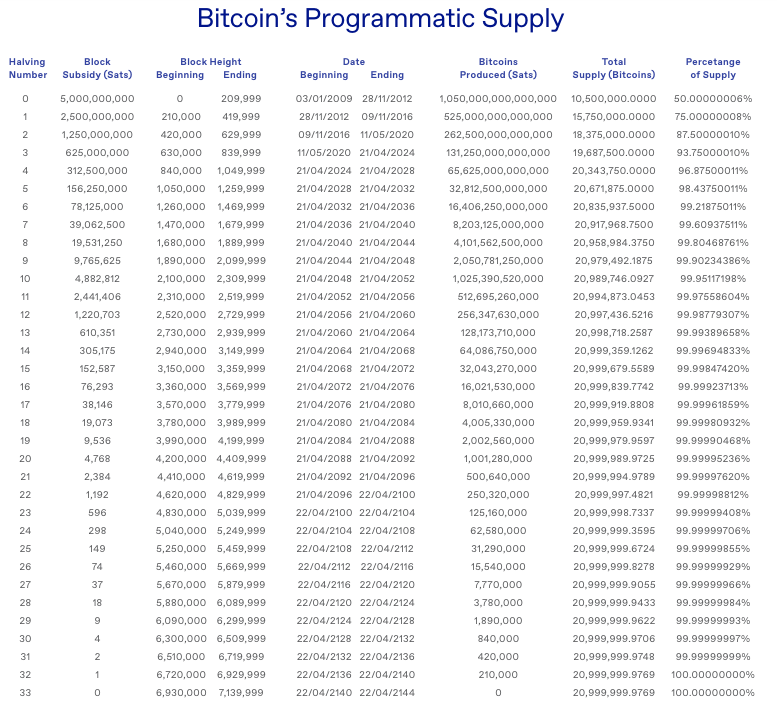
Economic Implications of Halving
Bitcoin halving has significant economic implications. Since block rewards are the way new Bitcoins are created, halving will reduce the annual growth rate of new Bitcoins (commonly referred to as "inflation rate") by 50%. In the short term, the growth of Bitcoin supply will decrease from 1.7% per year to 0.85% per year. The chosen limit of 21 million Bitcoins by Satoshi Nakamoto is not particularly special but is based on broad assumptions about acceptability and utility, with scarcity being the source of value. While the declining supply function may abstractly mimic the supply growth of real-world commodities, the actual annual supply growth of bulk commodities such as gold is exponential.
Another economic impact may be on the network itself. Bitcoin's block subsidy is the primary source of income for miners. Prior to the emergence of Ordinals over a year ago, block subsidies accounted for 97-98% of miner income, with transaction fees accounting for only 2-3%. Although this figure has recently jumped to 11.2%, the significant reduction of the primary source of miner income by 50% may still have important implications for network security and miners themselves.
Miner Income Depends on Block Subsidies
Miners are the lifeblood of Bitcoin, creating new blocks every 10 minutes. Miners play a crucial role in aggregating transactions and adding them to the blockchain. In return, miners earn Bitcoins through block subsidies and transaction fees.
Throughout Bitcoin's history, miner income has primarily come from block subsidies rather than transaction fees. Since its inception, block subsidies have accounted for 98.5% of miner income, with only 1.5% coming from transaction fees. The importance of transaction fees has been increasing, especially with the introduction of Ordinals and Inscriptions. In March of this year, transaction fees accounted for approximately 5% of miner income (this figure has recently jumped to 11.2%). In some recent blocks, transaction fees have even exceeded block subsidies. Despite this shift, miners still heavily rely on block subsidies, making halving a significant event for them. With the reduction of block subsidies after halving, miners will increasingly rely on transaction fees for income.
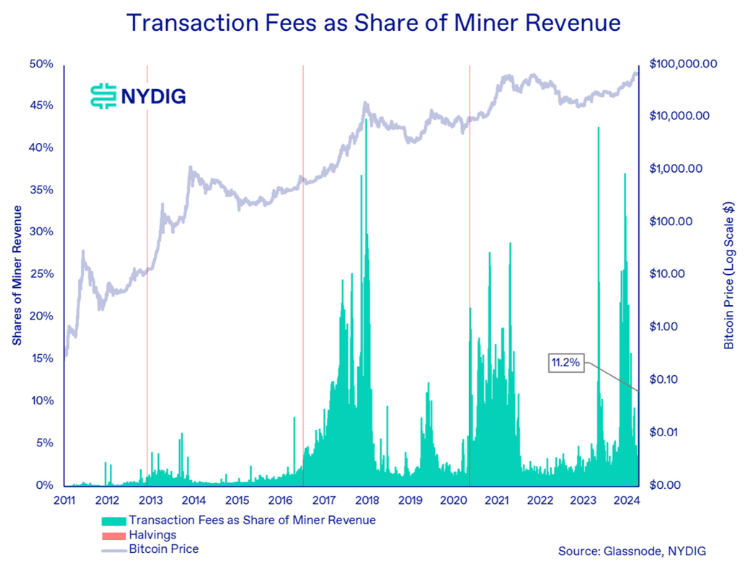
What Can We Learn from Previous Halvings?
This halving is the fourth for Bitcoin. Although the previous three halvings are not numerous enough to draw exact conclusions, they are still instructive because the development patterns of cryptocurrencies often repeat. Based on this, the price, network difficulty adjustment, hash rate changes, and hash price (the value of miner hash) before and after halving have some reference value for investors.
Price Performance
The impact of halving on the price of Bitcoin is a frequently discussed topic, especially for investors. While past performance does not predict future performance, there seems to be some repetition in past patterns. Looking back at previous halvings, Bitcoin has shown strong upward momentum, and this halving is no exception, with Bitcoin rising by 155% last year. In the 360 days before the previous three halvings, Bitcoin rose by 317%, 125%, and 23%, respectively.
Although Bitcoin has shown strong momentum in previous halvings, there has been even greater growth in the 360 days after halving. The increases after the previous three halvings were 2,819%, 803%, and 707%, respectively. An interesting difference in this halving is that Bitcoin reached a new all-time high before halving, unlike previous cycles where new highs were reached after halving.
While the outlook for the Bitcoin cycle remains optimistic, the surge in demand for spot ETFs may accelerate the return cycle.

Difficulty Adjustment Reflects Offline Hash Rate
The difficulty of Bitcoin is a key indicator of mining activity on the network and plays a crucial role in the process of creating new blocks. This indicator is directly related to the network's hash rate, which fluctuates based on miners coming online or going offline. Every 2,016 blocks, approximately every two weeks, the difficulty level is adjusted. The impact of the halving event on the mining economy cannot be underestimated, as it directly affects the size of the hash rate, thereby influencing the difficulty level. When the difficulty decreases, it means that less efficient miners are shutting down their machines. Historical data shows that miners increase their hash rate before the halving event, reflecting a significant increase in difficulty.
Although the difficulty may initially decrease at the start of the halving, the overall trend shows that the difficulty level will significantly increase in the 360 days after the halving. This highlights the resilience and adaptability of the Bitcoin network in response to changes in mining activity.
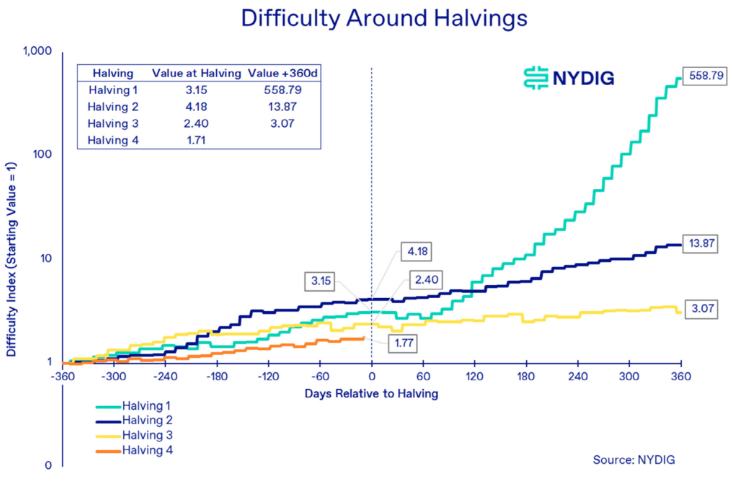
An important factor to consider during the halving period, especially for miners, is the potential impact of hash rate going offline due to decreased profitability. Since the halving essentially doubles the breakeven price for miners (excluding transaction fees), some speculate that mining machines operating above these costs may be forced to shut down.
However, NYDIG's prediction for this halving is that the hash rate is unlikely to go offline significantly (if at all) after the halving, as some of the oldest mining machines can still be profitable at current price levels. In previous halvings, the peak values of difficulty adjustments were 13.7%, 5.4%, and 14.7%, respectively.
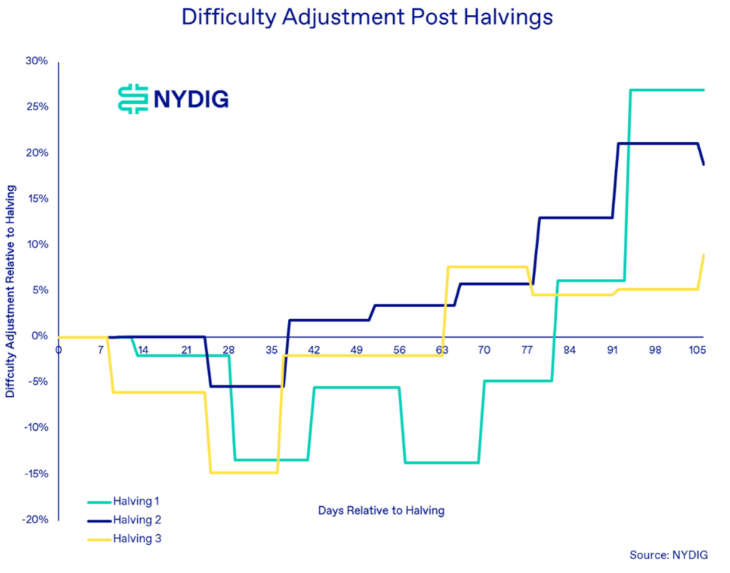
Halving of Hash Rate, Adjustment, but Continued Growth
The network hash rate reflects the pattern of difficulty adjustments before and after the halving, often showing a significant increase in the network hash rate as the halving approaches, as miners intensify operations to maximize returns. After the halving, the hash rate may temporarily decrease as less profitable mining operations go offline. However, historical data shows that the hash rate usually stabilizes and rebounds as the network adapts to the new environment. Based on the current market price and miner breakeven, most mining machines are not expected to go offline or shut down after this halving.
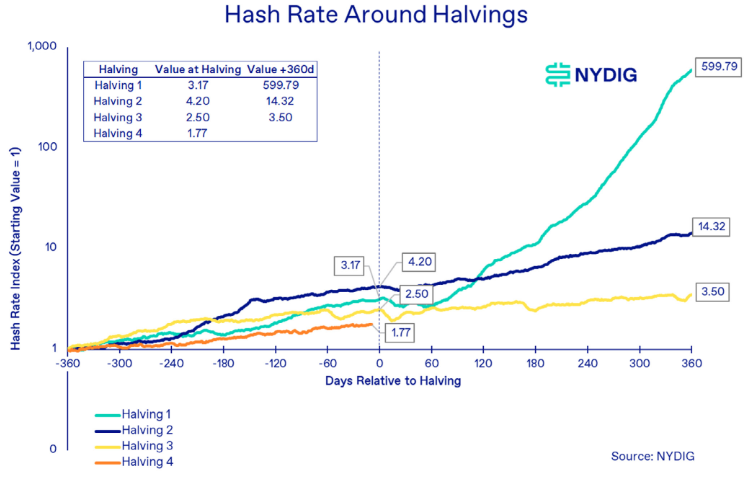
High Variability of Hash Price
The hash rate (referred to as hash price) is a critical factor for miners and undergoes significant changes before and after the halving, influenced by block rewards and transaction fees. In some cases, such as the current halving, the hash price surges before the halving, while in other cases, it decreases. Typically, after the halving, the hash price decreases by about 50%, depending on the contribution of fees to miner income. However, the results after 360 days post-halving are unpredictable, with some cases showing an increase from the initial levels, while others show a significant decline after a substantial increase.

Reduced Supply is No Longer as Important
Given the new supply reduction available to investors, a common view surrounding the halving event is its positive impact on price. It does sound true, as the daily supply of Bitcoin is expected to decrease by 450 on April 20th, which, at a price of $70,000 per Bitcoin, amounts to approximately $31.5 million in daily supply. However, in terms of global trading volume, this reduction accounts for only 59 basis points (about 0.6%) of the daily trading volume, a relatively small proportion. It is worth noting that this proportion was much higher in the past and may have had a greater impact on trading volume and price. For example, the first halving reduced the supply by about 10.64% of the trading volume, which was more significant compared to the current situation. NYDIG believes that demand, especially related to spot ETFs, will play a more crucial role in determining the price compared to supply.
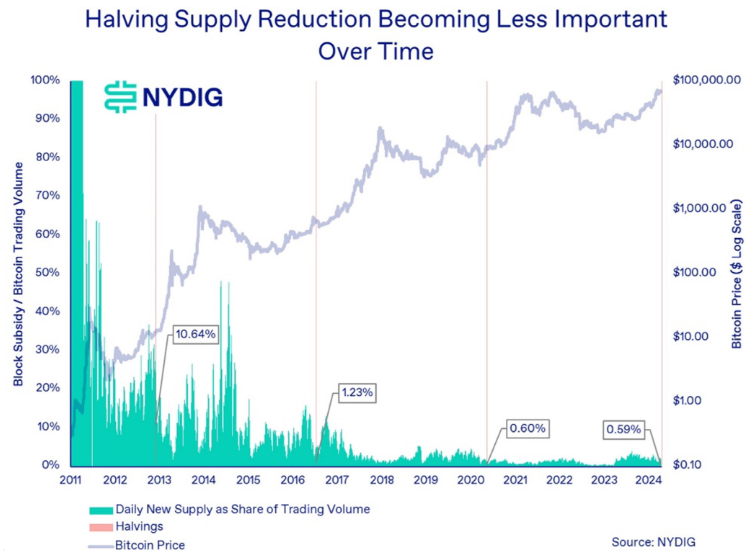
Conclusion
With the halving just completed, it is important to recognize its significance in Bitcoin's history. This rare phenomenon not only has technical significance but also has implications for the entire ecosystem's economy. While the direct impact of the halving on the price of Bitcoin may diminish over time, the halving is still a key factor in understanding the price cycle of Bitcoin. Although this event will reduce miner income, the halving and difficulty adjustments are fundamental features of Bitcoin's programmability and fixed supply.
Related reading: Exploring Bitcoin Halving: What Happened in the First Three?
免责声明:本文章仅代表作者个人观点,不代表本平台的立场和观点。本文章仅供信息分享,不构成对任何人的任何投资建议。用户与作者之间的任何争议,与本平台无关。如网页中刊载的文章或图片涉及侵权,请提供相关的权利证明和身份证明发送邮件到support@aicoin.com,本平台相关工作人员将会进行核查。



